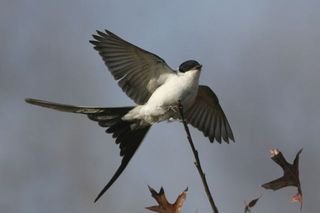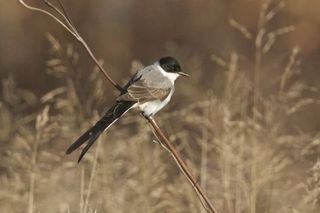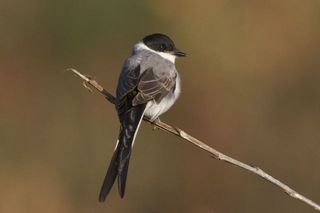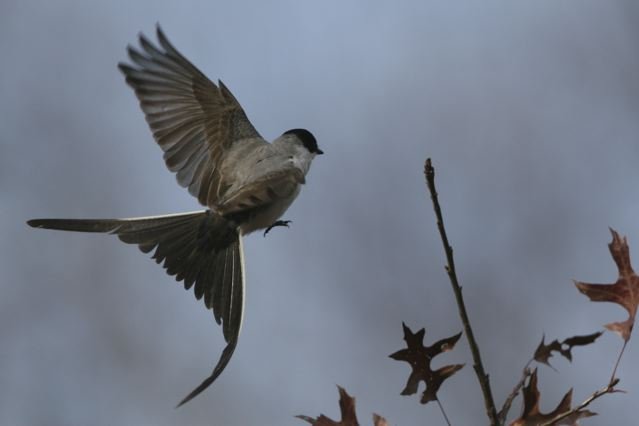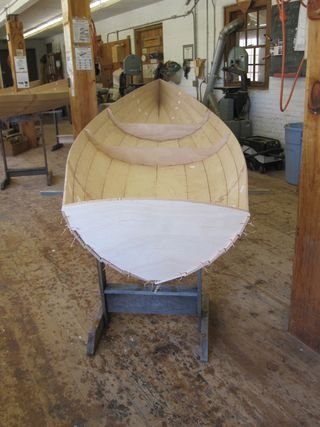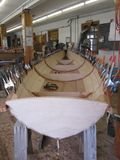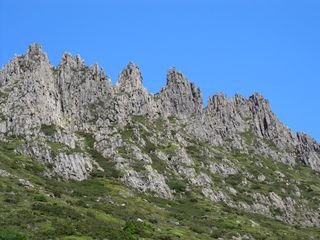Twitching
We all have our firsts that we record and hold close to our hearts: the first time I rode a bike, the first book I fell in love with, the first rock climb. Love is usually involved in these firsts, whether they involve kisses or not. But it appears to me that birders care more than others about firsts. The first time Peter sees a bird, he remembers that, makes note, place and date. Peter can’t remember all sorts of things, like what he did for Christmas last year, or what he ate for dinner the day before. But as we walk East Kingston he tells me, “this is where I got my life snow bunting.” Or at Croton Point is where he saw his first long eared owl, American coot, and rough legged hawk. I too have started to keep these firsts as part of my life story, remembering my first plummeting gannet, shown to me by a friend on Cape Cod. Or the vermilion flycatcher, seen on my first ever bird walk in the desert southwest. Or the greater sage grouse that walked out of the grasses in Wyoming and then soon enough disappeared into those grasses.
There is something special about being shown a new bird, as if Peter is offering me a gift: here, a Goldeneye. Here, a bufflehead. “There, a fox sparrow. It’s a pretty bird.” In their own way, they are all pretty birds, even the most common of them.
This, though, is the story of a different sort of birding first: the first time I have taken a trip just to see a bird. Not several birds, but one bird, a rare bird. The British call this twitching. Peter and I went twitching for a fork-tailed flycatcher.
We all have our firsts that we record and hold close to our hearts: the first time I rode a bike, the first book I fell in love with, the first rock climb. Love is usually involved in these firsts, whether they involve kisses or not. But it appears to me that birders care more than others about firsts. The first time Peter sees a bird, he remembers that, makes note, place and date. Peter can’t remember all sorts of things, like what he did for Christmas last year, or what he ate for dinner the day before. But as we walk East Kingston he tells me, “this is where I got my life snow bunting.” Or at Croton Point is where he saw his first long eared owl, American coot, and rough legged hawk. I too have started to keep these firsts as part of my life story, remembering my first plummeting gannet, shown to me by a friend on Cape Cod. Or the vermilion flycatcher, seen on my first ever bird walk in the desert southwest. Or the greater sage grouse that walked out of the grasses in Wyoming and then soon enough disappeared into those grasses.
There is something special about being shown a new bird, as if Peter is offering me a gift: here, a Goldeneye. Here, a bufflehead. “There, a fox sparrow. It’s a pretty bird.” In their own way, they are all pretty birds, even the most common of them.
This, though, is the story of a different sort of birding first: the first time I have taken a trip just to see a bird. Not several birds, but one bird, a rare bird. The British call this twitching. Peter and I went twitching for a fork-tailed flycatcher.
The fork-tailed flycatcher is a bird that belongs in Central or South America and for some reason turned north instead of south in its journeys. He—or rather she--is mistaking our fall for spring. It’s a common bird in its own territory, but here in the northern United States has been seen about one hundred times. This bird was reported on Wednesday, spotted by a woman on her morning walk, at a nature preserve near Stamford, CT. For several days, Peter reports that the bird is still there. He reads the email lists that keep birders informed about what is happening out there. “Why don’t we go?” I ask. I am not one to chase birds—there are enough birds out the front door to keep me both happy and busy and even, in the coming years when the excitement over a tree sparrow vanishes, I can’t imagine I will be one to journey for rarities. There are so many birds—common birds—I have not seen that twitching is ridiculous. Figuring out that I am looking at a purple finch still pleases me enormously. But there is something about the odd, small culture of birding I find fascinating. I’ve read a few books about big years, and know that central to these lists are the rarities, which real birders will spend thousands in air or helicopter fare to see. This trip won’t cost us much at all—gas down to Connecticut and back.
Traveling to see the flycatcher seemed like the sort of adventure that would appeal to Peter. Peter has been birding for six years and in that time has gathered an enormous amount of information on birds, and has travelled enthusiastically to create an impressive life list. And, he’s taken astonishing photographs along the way. So new birds for him are few and far between. Seeing a new bird is fun.
Peter, however, is noncommittal about chasing the flycatcher, perhaps because his dedication to local birds is so intense he would rather bird near home, to keep the pulse of what is happening here rather than chase a rarity. He likes to note the first tree sparrow of the fall or the last gasp of warblers. So we spend a morning with the local John Burroughs Nature Society (we are both trustees) at Kingston Point where it is windy and cold and no self respecting bird would be out. But soon the sun wins out over the clouds and warmth comes to us. We drive River road in the town of Esopus and get a long-distance view of a red-breasted merganser. And a canvasback, a new bird for me. These are dots on a wide, turbulent river, made clear by looking through the scope. Without trip leader Mark DeDea and Peter to guide me I would never figure out what I was looking at. Mark pulls out his worn guidebook. “Look at the difference in the forehead of this bird,” he explains. To him, the difference is painfully obvious. Yes, the red-breasted merg does have a steep forehead, so different from the lower forehead of the common merg. Of course! But really, from our distance I am impressed he can tell it is a merganser. “I’ve done this for twenty five years,” Mark explains. I am filled with envy.
After our morning birding, the day spreads before us. We eat breakfast, then get in the car, knowing that we won’t be in CT until 3:30, as the sun is going down. It won’t be good for pictures. But it seems the thing to do, an adventure of sorts. But, in fact, though there is the feel of adventure, there is no adventure whatsoever in finding this bird.
The crowded roads through southern New York and into CT gets us to the Cove Island Wildlife Sanctuary (website under construction), a few dozen acres of former landfill situated at the southern end of a vast parking lot (Peter, who lives near and daily birds the former Woodstock dump, thinks of this trip as “from one dump to another dump.”). A groomed park in the distance encourages dog walkers and joggers. An ice rink flanks the western end of the lot. A bunch of cars with birding stickers and people with bins and scopes leads us to the right spot. We walk quickly toward the trailhead, all excitement, only to be told to calm down, the bird is there, on the other end of a dirt path, though parts of the path are cordoned off. We loop around on the flat, wide trail and join a group of people who are standing with scopes looking into the bushes. And there the bird is—pretty simple to see. No chasing, no walking through the woods. We just got out of the car and that it is. Easy twitching.
I put my bins to my eyes and take a long look. I can see the bird’s white, compact body, its long dark tail. It’s an unmistakable bird with that long tail. If you cut off its tail the bird would look remarkably like an Eastern Kingbird, a bird that exists in the same Tyrannus genus as the flycatcher.
To get a clear look, I peer through the scope of a woman named Gayle who works for the girl scouts and has been there, witness to the bird for three days. She stands next to her husband Tom, “one of the best birders in New York,” Peter whispers to me. She is tanned, with a disheveled, warm smile. He is clean cut, serious about his birds but there’s a faint smile of pleasure as he looks at the bird and talks with us. I like them, the way I like people who are good at what they do and know it.
Late in the day the crowd is casual, having fun, chatting. I ask aloud to everyone and no one: what is going to happen to this bird? It seems oblivious, both to all of us admirers and to the fact it is in the wrong place. It is busy living its bird life, eating, pooping, perching. But soon enough there won’t be any flies for it to catch. I am worried about this bird. Tom shrugs, “It doesn’t look good.” It doesn’t. “But I hope it sticks around for a few weeks. This is my Christmas Bird Count sector,” Tom says with a grin. “That would be a good bird for a Christmas Bird Count,” I agree.
Gayle is generous with her scope, letting me look as Peter and I left ours in the car. There are perhaps twenty of us there on the flat, dirt path rimmed by a range of browned fall shrubs and grasses, all native plantings on this covered landfill. A cooper’s hawk wings through, drawing our attention away from the princess that is the flycatcher.
The little group of volunteers who have made this park hand out flyers, and try to keep the crowds controlled (over one hundred people were there at once the previous day) by roping off certain parts of the trail. They have made it so that the bird can fly from the southern end of their park—all trees—to the northern end, passing a set of feeders where finches, chickadees and other birds come and go, oblivious of their resident celebrity. The bird stays perched in a barren tree and from time to time drops to snag a bug—this mid-air bug snatching is called hawking or sallying. It has a broad beak, made to be able to snatch bugs mid-air. And then, in a loop, the bird returns to its perch where it chucks up the tough bits—the carapace--opening its beak wide. It has dark eyes set in a dark head so it’s hard to see its eye. The bird this evening sticks to the southern end, out of reach of good photos and in bad light. Peter takes some photos nonetheless, but they won’t turn out well—even I can see that. So we decide to stick around and photograph and look in the morning. As we leave the man in charge—a very friendly landscaper who has selected all of the native plants in this nature preserve—tells us that people have come from Las Vegas to see this bird. Must be someone on a big year. Many are from NYC, lots from CT, of course. Maine, Vermont, New Hampshire. People are willing to spend a lot—both in time and money—to see this bird.
We check into a hotel, making this bird cost more than just the gas of our drive down.
The next morning the bird is still there, waiting in the tree. In fact, the exact spot where we left him the night before. A group has already gathered, including a large woman in a huge parka who has flown in from somewhere. “I’ve got to stop the listing,” she announces to everyone. She has 660 birds on her list (though I’m not paying much attention so that number could be off). That the listing is taking away from the fun of birding. Indeed. I step away from her to watch the bird, warming in the early sun, the white of its chest brilliant. The bird preens, nonchalant, the dives for a bug.
There is a lot of lens power along the path, and Peter lets one woman look through his bins so she can see what she is missing. (If he were a Zeiss rep he’d be making some money; I bought my bins after looking through his.) At the end of the path is a fortress of tall photographers with their tripods spread wide. They all have cameras like Peter’s with 500 mm lenses. I say, “You guys are taking up some real estate here,” and not one of them laughs or says anything to me. They are very involved in themselves and their cameras. I am glad that Peter is roving on the edges of this group, flexible without a tripod, getting around and down to get some good shots. But the atmosphere this morning is different from the evening before. It’s tense, a bit competitive in an odd way—what exactly might we be competing for? It’s all about the bird, and less about anything else—the area, the plants, which are getting trampled. One of the volunteers, a sincere middle-aged woman, asks people to stay on the paths. For a while everyone listens and then some photographer just can’t help himself—he wanders out, tromping through the grasses.
After a while of watching, of hoping the bird will come near—it does, briefly and the snap of camera lenses resembles the click and whir of a quiet machine gun—Peter and I decide to explore what might be floating on the water. As we walk out we hear a cackling overhead and see a flash of green-yellow. Monk parakeets. Another new bird for Peter and for me.
“Let’s see if we can’t get to the northern side of this park,” Peter suggests, and we stumble onto an empty nature trail that leads into the park. And thirty feet in front of us in a tree is the bird. We stop in our tracks, aware we are onto something special. We don’t want to bother the bird, who is going about its morning feeding. So Peter steps to the side, near a tree, and starts to take photos as the bird lights up into the air, plummets down then, as if creating a full acrobatic circle, returns to its perch. It’s magical to watch, the flurry of such long tail feathers, the arc of the long wings, then the return to a pint sized bird on a tree, almost dazzled by herself.
I keep thinking how thrilling it would be to be the one who discovered this lost or wandering bird from South America. During this moment of crowd-quiet I have a sense of what that person might have felt. In our secluded spot there are no jokes, no swapping information about bins, or life lists. We are there alone with the bird for some time—perhaps 25 minutes, and I capture the feeling of discovery, of adventure.
For me, one of the great pleasures of birding is thinking of the miracle of seeing any bird. I have to be out in the world. The bird has to be nearby. Our paths must cross. It seems improbable, each bird a gift. And in that improbable moment I often think: I might be the only person who has ever seen this bird, who will ever admire its wings or beak, its boldness or cunning. In this case, with the flycatcher, I was so far from that special feeling. But in that quiet place, for a few minutes, I feel like we are alone with the bird. It is our bird.
Soon enough an older woman wanders down the trail and sees us. She too is delighted by this secret look but needs her husband to share it with her. We anticipate there will be a rush into our secret spot and in fact Peter’s arm is tired from hoisting the over ten pound camera to his eye, focusing and shooting. So we head out before others arrive, delighted by our time in the quiet, away from the mob.
We walk out toward Long Island Sound. The sun glints off the water, though in the distance we can see four tall cooling towers on the far side, on Long Island. Out on the water we see a range of gulls and some ducks as well--bufflehead and the long-tailed duck, which indeed does have a long-tail, and a marvelous white neck. A new bird for me. Three new birds in one trip. If I amortized the trip, it would come out to about 70-80 dollars per bird. Is it possible to calculate the cost of seeing a bird? I doubt it. Because I know that years down the road I’ll remember not just the first—probably only—fork-tailed flycatcher of this short, sweet life. I’ll remember this as the first time I chased a rare bird, the first time I twitched. But above all, that moment, the private viewing when Peter and I stood quiet on the grassy path and for a while had the bird to ourselves. What does the ad say? Priceless.
All photos by Peter Schoenberger
Boat School
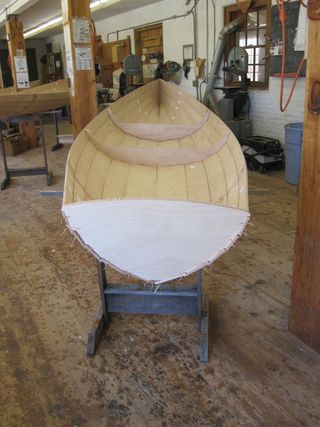
At noon on the second day of boat school, I folded up the
lines of plywood I had stitched together with copper wire. Before me rested
over seventeen feet of something that had the shape of a boat. It would sink, but
it had the feel of water about it. I was not particularly proud of my
accomplishment. All I had done was follow the careful but relaxed directions of
the teacher, a master boat builder named Geoff Kerr. What I had done to arrive
at my boat-like creation was all pretty basic. Drilled a few holes, cut copper
wire, slipped the wire through the holes and twisted them tight. My thumbs were
sore, my back a bit achy from standing and bending over for so many hours; I
had not done anything technically difficult. No wood to cut. No precision to
anything I had done. “Six inches between holes?” I had asked. “About, just eye
ball it.” Whatever might go wrong could be fixed. Nothing that sanding, epoxy
and paint could not fix.
At noon on the second day of boat school, I folded up the
lines of plywood I had stitched together with copper wire. Before me rested
over seventeen feet of something that had the shape of a boat. It would sink, but
it had the feel of water about it. I was not particularly proud of my
accomplishment. All I had done was follow the careful but relaxed directions of
the teacher, a master boat builder named Geoff Kerr. What I had done to arrive
at my boat-like creation was all pretty basic. Drilled a few holes, cut copper
wire, slipped the wire through the holes and twisted them tight. My thumbs were
sore, my back a bit achy from standing and bending over for so many hours; I
had not done anything technically difficult. No wood to cut. No precision to
anything I had done. “Six inches between holes?” I had asked. “About, just eye
ball it.” Whatever might go wrong could be fixed. Nothing that sanding, epoxy
and paint could not fix.
On the first night at the Wooden Boat School, Rich, the generous
and welcoming director, asked everyone to introduce themselves. One man ran a
boat yard down the way and wanted to learn bronze casting; another owned four
boats and needed to know more about diesel engines. A few from the coast guard
were there to learn how to inspect wooden boats. Many people were repeat
students. What was I doing there? All I knew was that I wanted to be a student
for a while, to learn something new that had nothing to do with books or words.
My class was to build an Annapolis
Wherry, a boat I had never seen or rowed but for some reason fell in love with
the sleek lines when I saw an image on the internet. In other words, this was a
version of internet dating, impulsive and perhaps all wrong.“Do you row?” people asked, trying to
understand why I was building this boat, which is 34 inches wide, and rows like
a crew boat, with a sliding seat. Nope. “Is this a stitch and glue boat?” I had
no idea. “Is it made of plywood.”
Probably. (One week later I could say yes, and yes to these last
questions).
I have not built many things in my life. In grade school I
bought balsa wood airplane models and under the guidance of Woogie Ham (not an
invented name; the boy was teased) did a lousy job of gluing them together. I
did not have the patience for the meticulous work of airplane building. Since
then I had acquired a few tools, though I used my drill mostly to hang pictures
on the wall or curtains in the bedroom. But I do have faith that with the right
instruction I can do anything, and that anything can be taught. I wanted to
learn, to be the student, not the teacher.
I am a teacher. I teach creative writing, the personal essay
and nature writing at Bard College. As my students struggle to get their
experiences into beautiful prose, I too also often say, “it will be ok, a
little sandpaper, a little paint, and we can figure this out. Just keep going.”
Determination, going into the writing every day, twisting those bits of copper wires
even if the act of twisting is not inspired, is as essential as the great idea.
Building is building, whether a sentence or a boat.
I was building my boat in the home town and final resting
place of one of the great writers and teachers of writing, E.B. White. For a
clean sentence he can’t be beat. His Elements of Style so often guides me: write
with nouns and verbs. Use the active voice. Don’t place words in the negative
if you can write it in the positive. In tribute to White, I have named my boat
To build something beautiful, truly radiant, I am sure that
it takes more than following the steps. Still, rules are helpful. Stir the
epoxy well. Try not to leave globs, but if you do you can sand them off later.
Try not to use adverbs, but if you do, edit them out later. And it helps to
have a teacher confident enough in his craft to let you make mistakes and still
believe it will all work out.
And lo, at the end of the week, I had a boat. Still not
something that would float—all those holes I drilled now needed to be filled
in--but I was getting closer. It gleamed in the light as I loaded it onto the
roof of my car. I have a few weeks of work left to do—filling and sanding,
daily work that with patience will add up to something called boat.
At the same time, with Elements of Style at my side, I will
be editing my manuscript about kayaking the Hudson River. Daily work that with
patience will add up to something called book.
.
Cradle Mountain

There are many reasons I traveled to Tasmania. Some I knew before I left—my friend to visit, the land, which is beautiful. Pademelons. Snakes. Echidnas. It was not until I was on the flight from Sydney to Hobart that I figured out one main reason. I had the window seat, another woman had the aisle. In between us, that one undesirable seat. Along came a woman, both tall and wide—I am guessing six feet. She slipped into that impossibly small seat, and pulled out a tiny book: Sense and Sensibility. Soon, of course, I was asking her questions. A Tasmanian (how many true Tassies are there?) who wouldn’t leave for the world. She announced: we hit population of 500,000 this year. 500,000 in a place the size of Ireland. Or Virginia. Suddenly I understood that the busyness and crowdedness of the world had been getting me down. I needed just to step outside of movement. Of cars lined up at stoplights. Of lines in the grocery store. Of endless emails that make it seem like the world has seeped into my living room. Tasmania was the place to escape.
It is, as far as that is possible. My cell phone did not work on the island. The internet is near nonexistent. Every place I visited I hiked alone, perhaps seeing a few other people.
And then I got to Cradle Mountain. Cradle Mountain was one of my top destinations. The Cradle Mountain Trail—the 65 kilometer overland walk—is, in a country with many overland walks, one of the most celebrated.To hike it with a tour costs about $2,800. For six days of hiking that must be some gorgeous scenery. Or good food.
When I drove the narrow road in toward the park, the mountains framing the horizon I sensed I was entering a special but crowded place. Suddenly here were all of the tourists in one spot, the Disney or Yosemite of Tasmania. I wanted to turn around and leave—could the natural beauty really offset the mass of people?
I was up at 6:30 and at the shuttle stop by 8 when the first
bus takes off for the hills. This shuttle reminded me of Denali National Park where
buses have taken over carting people in. Here it seems more essential as the
road is so narrow there were many places two vehicles just would not fit. Since
there were no worries of anyone coming down at this hour, the driver zoomed up
the steep incline while offering a constant patter of information about
helicopter rides and if we had a “spare few days we could hike the Overland
Track.” She asked how many were going up Cradle Mountain and the entire bus
raised their hand. There were women in tennis shoes that had about as much support
as a pair of Keds, there were young men carrying small plastic water bottles
and little less, there was a woman so overweight I was not sure she could get
on and off the bus. OK, I thought, here we all go.
I got off at the Ronny Brook stop, which is where the
Overland Track begins. The trail—or track—was once again a boardwalk through
low scrub. There were bushes in bloom by the side of the trail, dusty whites
and vibrant yellows. Mounds of scat graced the track, each piece the shape of
an oversized dice, piled like a pyramid. Wombat. Then the thin small scat of
the possum. I did not see the scat ragged with bones and fur that would
indicate Devils, though apparently there are some roaming the park.
Soon enough I entered a glade of trees, hiking up a wooden
staircase, a waterfall cascading to my right. I passed a group being guided up
the peak, a couple on their honeymoon (“New Zealand is better; everything is
bigger”). I kept leap frogging another couple—he with a small pack, she with
nothing—who got off the bus with me. In other words, front and back were people
lining the boardwalk that laced gracefully uphill.
Marion’s lookout perches high above Dove Lake (the
destination for most people). Spinning around at the lookout offers views of Crater
Lake, and of course the mountain we were all going to climb. A group of kids with
big packs ready for the Overland Track, rested and snacked. The smell of
perfume and deodorant and laundry detergent was so strong I struggled to
remember I was in the wilderness. I continued down the track and saw my first
snake of the day—a white lipped whip snake. With so many people on the trail I
assumed that snakes would steer clear. But there it was, dashing into the
brush. Later in the day, a
now-familiar tiger snake slipped by and a copperhead made its first appearance.
A small hut at the base of the mountain offers shelter in
bad weather. High and exposed, this rocky land looks weather-beaten, dramatic
with rain and snow. Crampon marks on the rocks tell stories of snow and ice. But
for this day it is all blue sky and sun, perhaps too much sun as later I cringed
seeing people with electric red arms and imagined the restless nights they
would spend. With a stiff wind it remained cool for the quick, craggy ascent
and amazingly I was alone through much of this. I boulder hopped and scrambled,
winding toward the far end of the citadel of rocks.
On the summit, two couples snacked tucked away from the wind
behind boulders near a large stone summit marker. A bronze plaque indicates the
names of the peaks visible in every direction. One energetic man offered to
take my photo—“jump on top of that marker,” he coaxed, and I did, worried that
the wind might knock me off. He bounded over, helping me down. I overheard him
speaking with the other couple about a place with identical box houses, all
painted a different shade of pastel and the Vietnamese woman who runs the café
in town who told him “You only get three chances in life, this is my second chance.”
I think I might have used up my three chances already.
“Is that Tarraleah you are talking about?” I asked. I had stopped
there en route to Cradle Mountain and this small town, based on power
generation was spooky with its tidy houses and huge pipelines.
“Yes!” He exclaims, “A bit Stepford, isn’t it?”
I agreed. He
and his girlfriend got ready to leave when she realized she had lost her hat. “You
lost your hat?” he asked bemused.
He hopped from one rock to another, looking for it. With the
wind, it was unlikely he might find it.
“Oh, silly Lilly,”
he said shaking his head and giving up the search.
“Silly Lilly”
ran through my head all day, the affection and disbelief intertwined.
On the scramble down I ended up in conversation with another
couple. Nichole has traveled the world, spent months in India. Phil is a jazz
trumpeter. I’m enchanted by their stories of travel, the sense of curiosity and
time that allows them to drift and live. And then the lens turned toward me,
America. Within moments, there she was:
Sarah Palin. She was the one subject everyone I met wanted to talk
about.
“Yeah, Sarah Palin,” I said with a sigh. How is it possible
to explain how she emerged on the national political scene?
In their eyes shone the glee of incredulity.
I looked away with embarrassment.
We parted at a junction where I had to decide whether to go
around another peak and to Twisted Lakes, or down to Dove Lake. I was roasting
hot and low on water, despite carrying two liters. The Lake looked inviting and
I saw a swatch of sand; my swimsuit was tucked in my pack. So I plunged down,
through a dense, moist forest, astonishing because I had just been in the
desert, red dry soil under my feet. On the way down I met my first Americans,
from New Jersey no less. So we walked in concert and at the swim hole plunged
in together.
Before heading back to the parking lot, with a throng of
older people in sensible shoes, I swam out into the lake one more time: out
doing the backstroke in memory of my father, in doing the breast stroke in
memory of my mother. And they were with me, the best company I had had all day.
I felt ridiculous complaining about the crowds; so fast,
though, Tasmania had spoiled me. I had come to see each trail or view as my
own, had come to treasure the deep, ringing silence available only when the
patter of the world is miles away. On this one day I spoke to more people than
I did the whole trip. Those conversations added their texture to the land, but
had I missed any tiger snakes? Any fresh blooms? Might a Devil have slipped by
without me—deep in conversation—noticing?
Lake St. Clair

Snakes. Tasmania has three snakes: the Tiger snake, which is long and black; the White-lipped snake, also known as a whip snake, which is mid-sized, compact, moves in a vigorous manner and is a dusky green; and the copperhead. On my walk from the end of Lake St. Clair, Narcissus, back to the Visitor’s Center, 16.2 kilometers I encountered two human beings, two tiger snakes and two whip snakes. Which means that by the end of the hike I feel more like a snake than a person, more a part of the land than of civilization, more fond of dirt than the internet, more silent, fast and sleek than ever before.
Snakes. Tasmania has three snakes: the Tiger snake, which is
long and black; the White-lipped snake, also known as a whip snake, which is
mid-sized, compact, moves in a vigorous manner and is a dusky green; and the
copperhead. On my walk from the end of Lake St. Clair, Narcissus, back to the
Visitor’s Center, 16.2 kilometers I encountered two human beings, two tiger snakes
and two whip snakes. Which means that by the end of the hike I feel more like a
snake than a person, more a part of the land than of civilization, more fond of
dirt than the internet, more silent, fast and sleek than ever before.
Lake St. Clair is the end of the famous Cradle Mountain
hike, which begins 65 kilometers to the north. Fifty hikers a day start their
journey there and end up six days later at Lake St. Clair. You would think
given this volume that the trail might be crowded with humans. It is not.
The campground is nicely divided: vans on one side, tents on
the other. In the tent area, most people look like serious hikers with good
packs and firm calf muscles. There are few children and more young couples,
girls giggling in the tents, and a couple of young Asian women dabbing cream
onto their faces in the bathroom. I woke to the sound of wind in the trees.
Imagining bad weather, I parted my tent door to blue sky and am transformed. Weather-wise
luck was with me on this trip. I
was lucky in other ways as well.
I headed out for a magnificent day. I boarded a small motor
boat for a quick ride to the end of the lake. I would hike back from there. The boat stops first at Echo Point where
the other four people on the boat get off. From Echo Point it is a three hour
return hike. As we dock, I spied a
bird on a rock just offshore. A Welcome Sparrow, which has a vivid rust-orange
bib. It feels like a good omen for the day.
Alone with the captain, I continue on to Narcissus. I ask
him the names of the mountains—the Acropolis, the Parthenon. Indeed they have a
similar blocky structure. Finally I had asked too many questions and he admits
he does not know, has only worked this boat for ten days. He and his wife had
been traveling for six months, looking for what life might toss them. And here
they now are, living in Derwent Bridge, he the captain of a small boat on Lake
St. Clair. This is a familiar story to Australians, I imagine, the six month
drive about a tale I heard many times from people I met. Pack up and go, see
what you can see, begin life anew. It’s an appealing story. And every version I
heard ended happily.
At Narcissus, a dozen people were waiting, having just
finished the Cradle Mountain Trail. Rather than hike the final day, they have
opted for a ride. It looks like a boy scout group, with two leaders.
Once the boat pulled away silence descended. I marveled at
the color of the stream leading into the lake, a blue-black but clear. Again, I
had one of those wonderful Tasmanian boardwalk trails as I head off for what
should have been a five and a half hour walk, but which in fact takes me seven.
Perhaps I walked slowly. I know I stopped a long time for lunch. I took dozens
of photos. I dodged snakes, tried to spy birds calling, taunting me from the
green forest. I did not have a single thought that extended beyond the horizon. In other words, I had finally been gone
from the world long enough, been alone long enough (had not had a conversation
beyond “hello” for four days), been hiking long enough that my mind had leveled
into a meditative state. The simple way of saying this is I was happy.
The sky was azure blue. I could see far into the distance—the
lake is cradled by low lying mountains, some rising abruptly (Mt. Ida) others
table-topped. I was feeling pretty pleased with everything: the weather, my
mood, the scenery. The stretch of trail from Narcissus to Echo is glorious,
with lots of sandy scallop beaches just off the trail. Myrtle trees with their
feathery leaves dominate the trail side. I stopped and sat in the sand, contemplated
swimming but decided the effort would not be worth it. I ate lunch under a high
sun and cooled by a glorious wind.
It was just before lunch that I spied my first snake. A long
black Tiger snake. It wandered off in elongated confidence, knowing it owned
the trail, the woods. Its appearance, so sudden, put me on edge. In fact, I
stopped for lunch early in the hopes that a break and some food would calm me
down so that I did not walk in anticipation of the next snake. Ten minutes
after lunch my first whip snake dashed into the undercover, its taught greenish
body moving in a tight S.
At Echo Point the boat was pulling out after making an
afternoon drop off. A young couple sat rolling a cigarette. We shared hellos. I
told them about the snakes. We walked a bit together. She worked in an outdoor
store, he is a firefighter. They were on their Australian six-month drive
around. They had started in Darwin and headed straight south, through Alice Springs.
“Lots of desert,” she reported.
I toodled ahead of them and there right in the middle of the
trail, moving toward me was another tiger snake. I assumed he would veer off
but he did not as I backed up and he kept on his merry way. I backed up a few
yards, then some more, then some more. The snake was cheerfully oblivious that
I was losing ground. When the couple caught up to me I was standing in the
trail, hoping the snake had left.
“There was a snake,” I reported, feelinga bit foolish.
The man and I walked forward and peered over the log where
he was last seen. Mr. snake was right there, taking a break. As I screamed and
backed up, the man took a stick and encouraged it into the brush. I slipped by.
The trail after Echo is not as nice as the stretch from
Narcissus.The lovely myrtle changed
to the enormous sweet gum, which so shelters the forest floor that the only
thing that survives are ferns. Before there was some real diversity—silver
wattle, for instance. And several bushes in bloom, white, light pink.
I returned to my tent, stretched out for a bit until an
echidna mooched its way through the camp ground. It waddled along, then shoved
its long snoot into the ground, looking for grubs and ants. Though the echidna
looks like an anteater or a hedgehog they are not related; the similarities are
due to convergent evolution (that is, similar characteristics that develop in
different lineages). In Greek Echidna means “she viper,” and in ancient
mythology the Echidna was the mother of all monsters. Hard to believe, given
the almost square creature I followed with my video while two little girls
decided it must be someone’s pet and their father tells them it is waddling off
to its bed.
I walked back to the visitor center hoping for a lamb chop
dinner. When I arrived, the place had folded up, the chef and workers at a
table finishing off their own dinners.
“I thought you were open until 8,” I said.
“No one came to eat tonight, so we closed early,” the young
man explained.
I stepped back, the disappointment obvious on my face. I
tried to imagine what I might pull together to call dinner. I was hungry beyond
the peanut butter, stale bread, and cup of soup that I had. I tried to convince myself I’d be fine.
The chef called to me as I left. “Listen,” he said, “go to
the hotel in Derwent Bridge.”
“Will they still be serving?”
“I’ll call and confirm,” he said. “I got a young woman here who needs a meal,” he said into the
phone, “she’s wearing a Penn State t-shirt.” Pause. “I won’t tell her you asked
that.”
He hung up. “He wanted to know if you are wearing a bra.”
Over dinner I read more of In Tasmania. The passage was apt for my day. An early
settler, Travers, was bit by a Tiger Snake. His foot swelled up and he was
bleeding from the ears. Then his foot turned black. At this point, his
companions, Greenhill and Pearce, (Greenhill and Travers were, according to
this narrative, lovers) ate him. Cheerful. Cackling over this tale it was now
clear what would happen to me if one of those snakes got me.
At five the next morning I was awake with my own excitement.
I knew that if I walked out to the platypus viewing area, I’d see one. So I
did. And I did. It swam out in the lake, dove, resurfaced, dove. And I watched
the sun rise and knew I was set for another perfect day.

